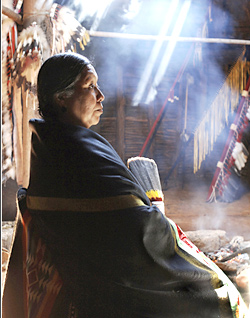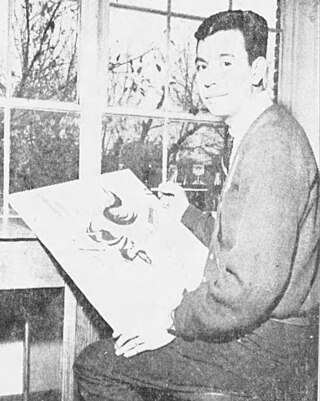Related Research Articles

The Institute of American Indian Arts (IAIA) is a public tribal land-grant college in Santa Fe, New Mexico, United States. The college focuses on Native American art. It operates the Museum of Contemporary Native Arts (MoCNA), which is housed in the historic Santa Fe Federal Building, a landmark Pueblo Revival building listed on the National Register of Historic Places as Federal Building. The museum houses the National Collection of Contemporary Indian Art, with more than 7,000 items.

The Oglala are one of the seven subtribes of the Lakota people who, along with the Dakota, make up the Očhéthi Šakówiŋ. A majority of the Oglala live on the Pine Ridge Indian Reservation in South Dakota, the eighth-largest Native American reservation in the United States.
Teri Greeves is a Native American beadwork artist, living in Santa Fe, New Mexico. She is enrolled in the Kiowa Indian Tribe of Oklahoma.

Vanessa Paukeigope Santos Jennings is a Kiowa/Kiowa Apache/Gila River Pima regalia maker, clothing designer, cradleboard maker, and beadwork artist from Oklahoma.

Arthur Douglas Amiotte is an Oglala Lakota Native American painter, collage artist, educator, and author.

Tonita Peña born as Quah Ah but also used the name Tonita Vigil Peña and María Antonia Tonita Peña. Peña was a renowned Pueblo artist, specializing in pen and ink on paper embellished with watercolor. She was a well-known and influential Native American artist and art teacher of the early 1920s and 1930s.
Gina Gray : was an Osage artist born in Pawhuska, Oklahoma, to Andrew and Margaret Gray. She was the great-granddaughter of Henry Roan Horse. She is one of the most renowned Native American contemporary artists of the past three decades, having won awards from and held exhibits at many museums and art shows throughout Indian Country.
Dyani White Hawk is a contemporary artist and curator of Sicangu Lakota, German, and Welsh ancestry based out of Minnesota. From 2010 to 2015, White Hawk was a curator for the Minneapolis gallery All My Relations. As an artist, White Hawk's work aesthetic is characterized by a combination of modern abstract painting and traditional Lakota art. White Hawk's pieces reflect both her Western, American upbringing and her indigenous ancestors mediums and modes for creating visual art.
Jamie Okuma is a Native American visual artist and fashion designer from California. She is known for beadwork, mixed-media soft sculpture, and fashion design. She is Luiseño, Wailaki, Okinawan, and Shoshone-Bannock. She is also an enrolled member of the La Jolla band of Indians in Southern California where she is currently living and working.

Josephine Myers-Wapp was a Comanche weaver and educator. After completing her education at the Haskell Institute, she attended Santa Fe Indian School, studying weaving, dancing, and cultural arts. After her training, she taught arts and crafts at Chilocco Indian School before joining the faculty of the newly opened Institute of American Indian Arts in Santa Fe. She taught weaving, design, and dance at the institute, and in 1968 was one of the coordinators for a dance exhibit at the Mexican Summer Olympic Games. In 1973, she retired from teaching to focus on her own work, exhibiting throughout the Americas and in Europe and the Middle East. She has work in the permanent collection of the IAIA and has been featured at the Smithsonian Institution. Between 2014 and 2016, she was featured in an exhibition of Native American women artists at the Museum of Indian Arts and Culture in Santa Fe.

Jeri Ah-be-hill was a Kiowa fashion expert and art dealer. She owned and operated a trading post on the Wind River Indian Reservation for more than twenty years before moving to Santa Fe, New Mexico where she became the curator of the annual Native American Clothing Contest held at the Santa Fe Indian Market. She also worked as a docent at both the Institute of American Indian Arts and the Wheelwright Museum of the American Indian. Considered an expert on Native American fashion, she traveled nationally presenting educational information about tribal clothing.
Wendy Ponca is an Osage artist, educator, and fashion designer noted for her Native American fashion creations. From 1982 to 1993, she taught design and Fiber Arts courses at the Institute of American Indian Arts (IAIA) of Santa Fe and later taught at the University of Las Vegas. She won first place awards for her contemporary Native American fashion from the Santa Fe Indian Market each year between 1982 and 1987. Her artwork is on display at IAIA, the Los Angeles County Museum of Art, the Philbrook Museum of Art and the Smithsonian Institution's National Museum of the American Indian.

Native American fashion is the design and creation of high-fashion clothing and fashion accessories by Native Americans in the United States. This is a part of a larger movement of Indigenous fashion of the Americas.
Margaret Roach Wheeler is a Chickasaw/Choctaw weaver and Native American fashion designer. Her work has been widely recognized for her scholarship in researching designs and techniques which existed prior to conquest and incorporating design elements into her woven garments. Her work has been featured in numerous collections including the Smithsonian's National Museum of the American Indian, where she has also served as a visiting artist and received a research fellowship. She was inducted into the Chickasaw Nation Hall of Fame in 2010 and was honored by the State of Oklahoma with the Governor's Arts Award in 2018 for her unique contributions to art. She is the founder of Mahota Textiles.

Joyce Growing Thunder Fogarty, is a Native American artist. She is of the Assiniboine Sioux, Dakota people, and is known for her beadwork and quillwork. She creates traditional Northern Plains regalia. The Smithsonian named her as "one of the West's most highly regarded beadworkers".
Marty Two Bulls Sr is an American editorial cartoonist. He was a finalist for the Pulitzer Prize for Editorial Cartooning in 2021, but the award was not given that year.
References
- ↑ "Fine Art and Outsiders: Attacking the Barriers". The New York Times. 9 February 1996. Retrieved 6 June 2017.
- 1 2 "Native Arts & Culture « Comment Page 1". greenfiretimes.com. Retrieved 6 June 2017.
- 1 2 "Imogene Gooshot". New Mexico Digital Collections. University of New Mexico. Retrieved 23 October 2019.
- ↑ "Fort McDowell Indian Art Show draws crowds" . Retrieved 6 June 2017.
- ↑ Charlotte Streifer Rubinstein (1990). American women sculptors: a history of women working in three dimensions . G.K. Hall. ISBN 978-0-8161-8732-4.
- ↑ Lucy R. Lippard (1990). Mixed blessings: new art in a multicultural America . Pantheon Books. ISBN 978-0-394-57759-3.
- ↑ Lincoln, Kenneth (1993). Indi'n Humor: Bicultural Play in Native America. Oxford: Oxford University Press. p. 142. ISBN 0-19-506887-4.
- ↑ "Fenimore Art Museum". collections.fenimoreartmuseum.org. Retrieved 6 June 2017.